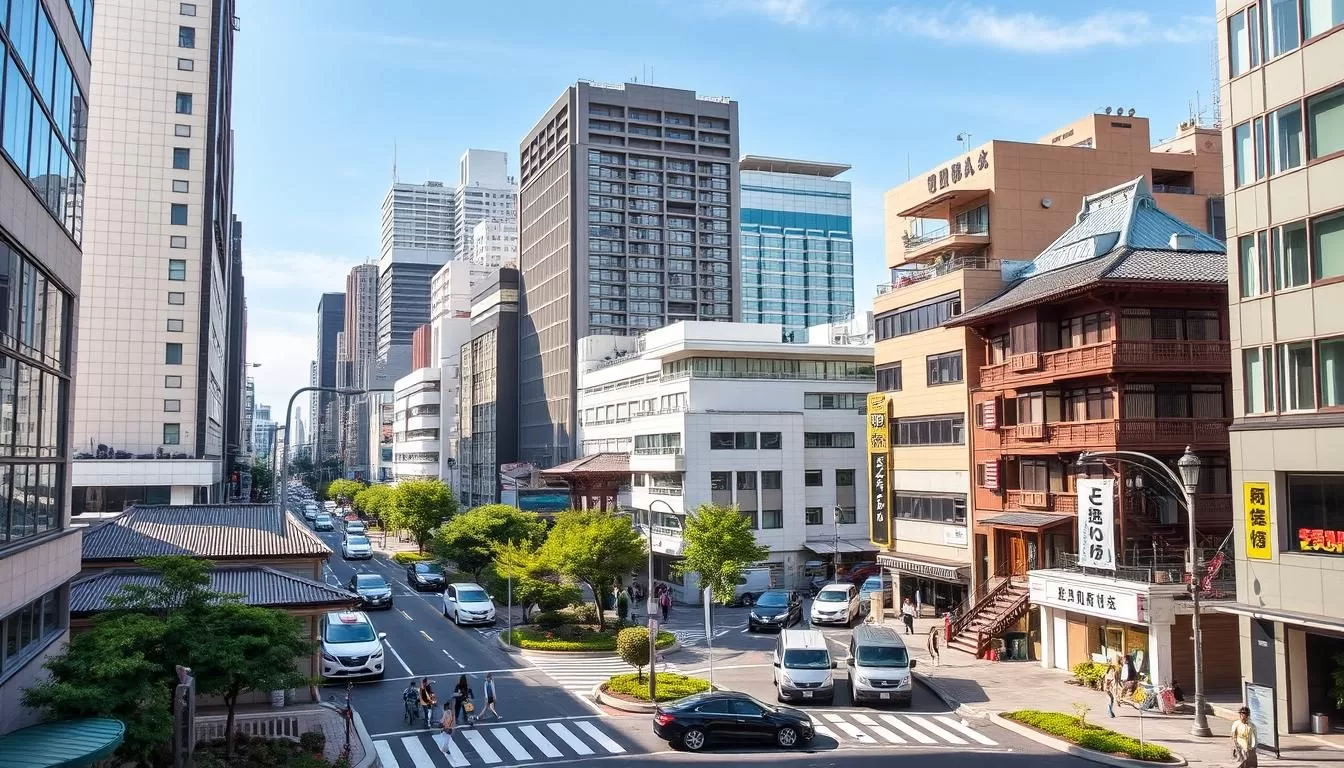✓ Accommodations ✓ Flights ✓ Rental Cars ✓ Tours & Activities
You’re about to explore one of Tokyo’s most fascinating districts – Chiyoda-ku, the historic and political heart of the city.
This special area is home to the Imperial Palace and numerous cultural landmarks, offering a unique blend of historical sites, modern architecture, and cultural experiences.
As you visit Chiyoda-ku, you’ll discover top attractions, activities, and experiences that cater to all types of travelers, from history buffs and architecture enthusiasts to foodies and shoppers.
This guide will help you navigate the district, providing practical information on transportation, accommodation, and seasonal highlights, ensuring you make the most of your time in this incredible place.
Discovering Chiyoda-ku: The Heart of Tokyo
As you step into Chiyoda-ku, you’re not just entering a ward; you’re stepping into the very heart of Tokyo. This district is where the city’s past and present converge, creating a unique blend of historical landmarks and modern attractions.
![]()
Historical Significance of Chiyoda Ward
Chiyoda Ward is steeped in history, having served as the political and administrative center of Japan for centuries. The area’s origins trace back to Edo Castle, also known as Chiyoda Castle, which housed the Tokugawa Shogunate for over 250 years. During this period, the surrounding area was home to numerous samurai residences, setting the stage for its future as a hub of governmental and administrative functions.
With the advent of the Meiji period, Edo Castle was transformed into the Imperial Palace, becoming the Emperor’s residence. This transition marked the beginning of Chiyoda-ku’s evolution into the political heart of modern Japan. The ward continued to grow in significance with the construction of the Diet Building and various government ministries and agencies around the Imperial Palace.
- The historical significance of Chiyoda Ward is deeply rooted in its role during the Edo period.
- The Meiji Restoration played a crucial role in transforming the area into the political center of Japan.
- The ward’s historical landmarks, such as the Imperial Palace, continue to attract visitors from around the world.
Geographic Location and Layout
Chiyoda-ku is centrally located in Tokyo, encircling the Imperial Palace. The ward is surrounded by several key neighborhoods, including Marunouchi, Otemachi, Hibiya, and Kanda, which form the core of Tokyo’s business and governmental activities. This strategic location has made Chiyoda Ward a hub for both national government functions and international business.
The ward’s layout is characterized by a mix of historical sites and modern buildings. The area around the Imperial Palace is particularly noteworthy, with its blend of traditional and contemporary architecture. The district is also home to the Kasumigaseki government office district, further solidifying its role as the administrative heart of Japan.
| Neighborhood | Description |
|---|---|
| Marunouchi | A major business district known for its modern architecture and shopping areas. |
| Otemachi | A significant financial district with numerous corporate headquarters. |
| Hibiya | A bustling area known for its entertainment and shopping options. |
Why Chiyoda-ku Is Worth Visiting
Chiyoda-ku offers a unique experience for visitors, combining historical exploration with modern attractions. The ward is home to numerous cultural landmarks, including museums and historical shrines, making it a fascinating area to explore. Visitors can enjoy a range of activities, from traditional tea ceremonies to shopping in modern complexes.
Despite suffering significant damage during the Great Kanto Earthquake and World War II, Chiyoda-ku has continued to evolve and recover. Today, it stands as a testament to Tokyo’s resilience and its ability to blend the old with the new. The ward’s ongoing development, including new residential areas, is bringing a fresh vibrancy to this traditionally office-dominated district.
Whether you’re interested in history, culture, or simply experiencing the heart of Tokyo, Chiyoda-ku has something to offer. Its unique blend of past and present makes it a compelling destination for any traveler.
The Imperial Palace and Grounds
As you step into the heart of Tokyo, the Imperial Palace stands as a testament to Japan’s rich history and imperial heritage. The palace is not just a residence for Japan’s Emperor and his family but also a symbol of the country’s cultural and historical significance.
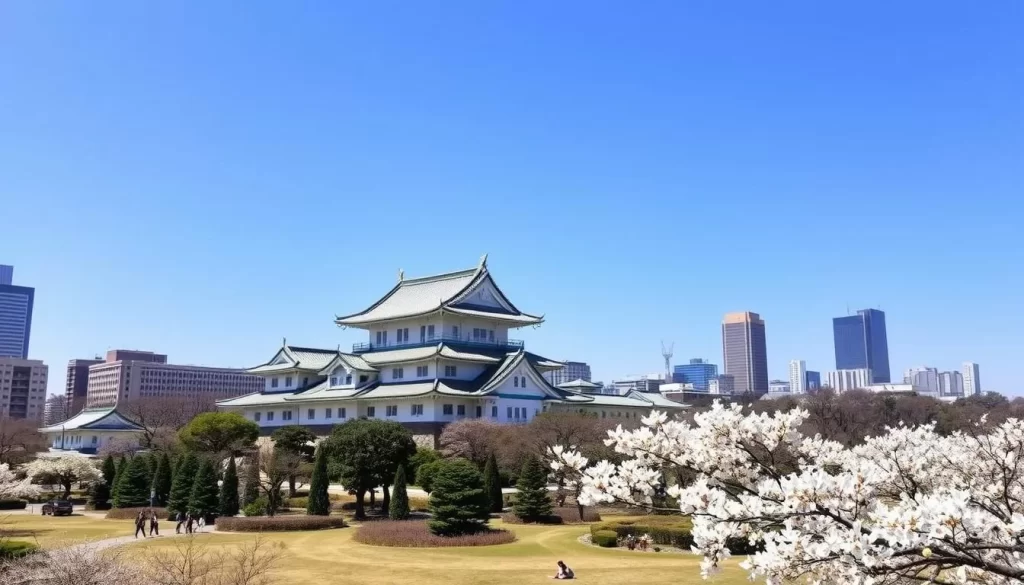
Tokyo Imperial Palace: Japan’s Royal Residence
The Tokyo Imperial Palace, situated on the grounds of the former Edo Castle, is the primary residence of Japan’s Emperor. The palace complex is where the Emperor undertakes official duties, making it a crucial part of Japan’s imperial system. The current palace was built on the site of the old Edo Castle, which was destroyed during World War II. Although the grounds are not open to the public, you can visit the palace through guided tours available on Tuesdays to Saturdays at 10:00 and 13:30. These tours, conducted in both Japanese and English, last approximately 75 minutes and provide a unique insight into the palace’s history and significance.
To participate in one of these tours, you must apply through the Imperial Household Agency’s official website. This process ensures that visitors can experience the palace’s grandeur while respecting its role as an active imperial residence.
East Gardens of the Imperial Palace
In contrast to the palace itself, the East Gardens of the Imperial Palace, or Higashi Gyoen, are open to the public and offer a serene escape from Tokyo’s bustling streets. These gardens feature beautiful Japanese landscaping, including a rose garden, a bamboo grove, and the Ninomaru Grove and Garden. Visitors can stroll through the gardens, enjoying the tranquil atmosphere and the changing seasons. The gardens are open daily, except for Mondays, Fridays, and special occasions, from 9 am until between 16:00 and 18:00, depending on the time of year.
The East Gardens are a testament to Japan’s gardening traditions and offer a peaceful retreat in the heart of the city. Whether you’re interested in nature, history, or simply looking for a quiet spot to relax, the East Gardens are a must-visit destination.
Imperial Palace Moat and Nijubashi Bridge
One of the most iconic features of the Imperial Palace is the Nijubashi Bridge, a two-arched stone bridge that serves as the entrance to the inner palace grounds. While the bridge itself is not accessible to the general public, it can be viewed from the Kokyo Gaien Square, offering a glimpse into the palace’s majestic architecture. The surrounding moat, part of the former Edo Castle’s defenses, adds to the palace’s picturesque setting and is a popular spot for photography.
The Nijubashi Bridge and the moat are not only significant historical features but also provide a beautiful backdrop for visitors to the area. As you explore the surroundings, you can appreciate the blend of traditional Japanese architecture and the natural beauty of the gardens and water features.
Cultural Landmarks and Museums
The heart of Tokyo, Chiyoda-ku, boasts an array of cultural landmarks and museums that are a must-visit for anyone interested in art, history, and science. As you explore this vibrant ward, you’ll discover a rich tapestry of cultural attractions that showcase Tokyo’s heritage and its contemporary flair.
National Museum of Modern Art
Located next to the East Gardens of the Imperial Palace, the National Museum of Modern Art in Tokyo (MOMAT) is a treasure trove for art enthusiasts. Established in 1952 as Japan’s first national art museum, MOMAT houses a collection of over 12,500 artworks, featuring notable Japanese artists from the Meiji period and contemporary Western artists. The museum’s “MOMAT Collection” showcases approximately 200 works from its vast collection.
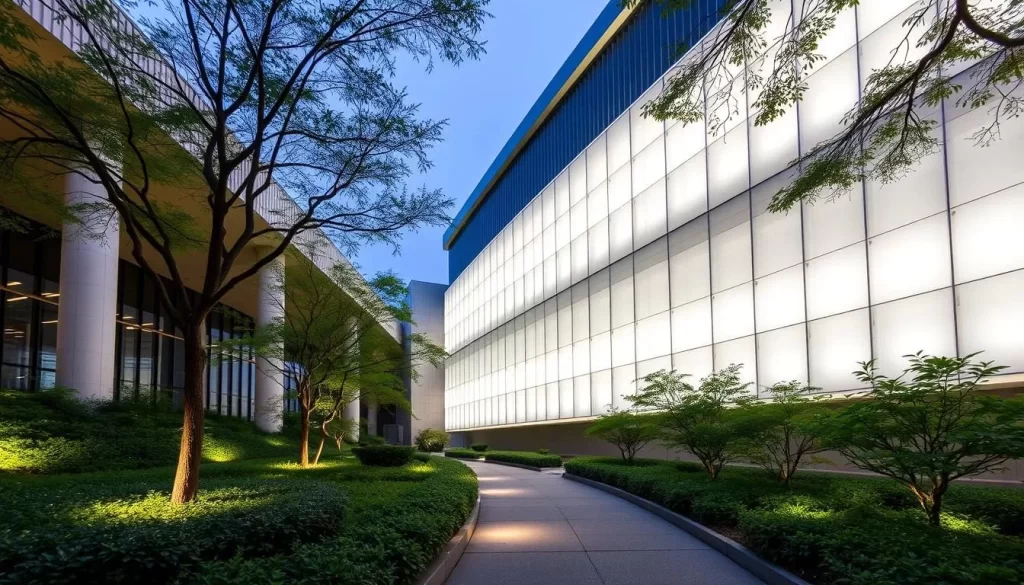
MOMAT is open Tuesday to Sunday from 10:00 to 17:00, with extended hours until 20:00 on Fridays and Saturdays. Visitors can enjoy various exhibitions, including special exhibitions held several times a year. Whether you’re an art aficionado or just looking to explore Tokyo’s cultural scene, MOMAT is a compelling destination.
Science Museum
The Science Museum, situated in the heart of Chiyoda-ku, offers an engaging experience for visitors of all ages. With about 20 themed exhibition rooms across four floors, the museum provides an interactive approach to learning about science and technology. Visitors can enjoy hands-on exhibits, experimental shows, and craft workshops, making it an ideal destination for families and science enthusiasts.
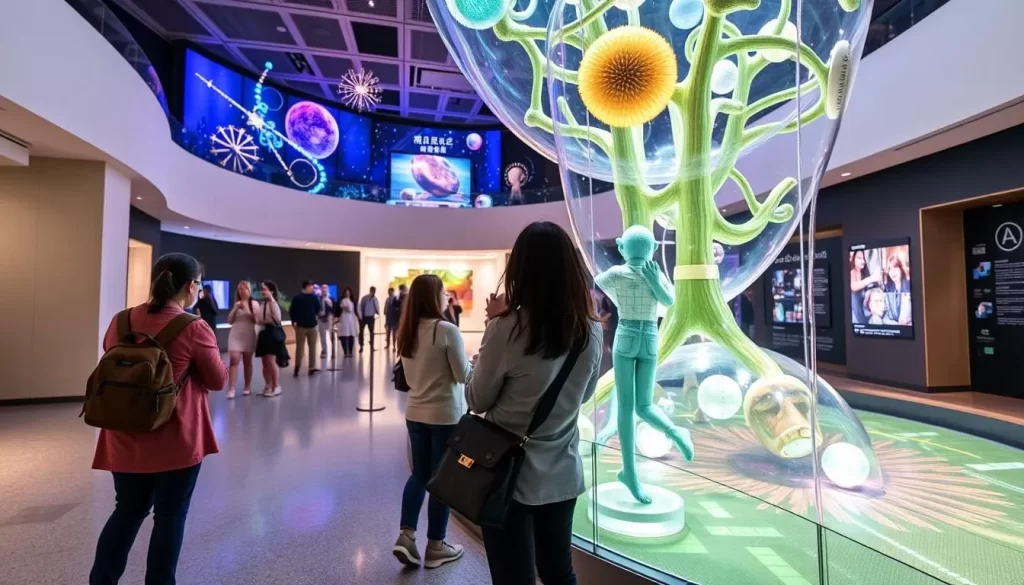
The Science Hall, a full-scale theater within the museum, hosts lectures, seminars, and presentations related to scientific advancements and discoveries. With a capacity of 410 people, it’s an excellent venue for those interested in exploring the latest in science and technology.
National Showa Memorial Museum
The National Showa Memorial Museum provides a poignant insight into the hardships faced by Japanese citizens during and after World War II. Since its opening in 1999, the museum has welcomed over 5.3 million visitors. The museum’s permanent exhibition is particularly noteworthy, offering free admission to elementary and junior high school students, who can learn through interactive exhibits and videos.
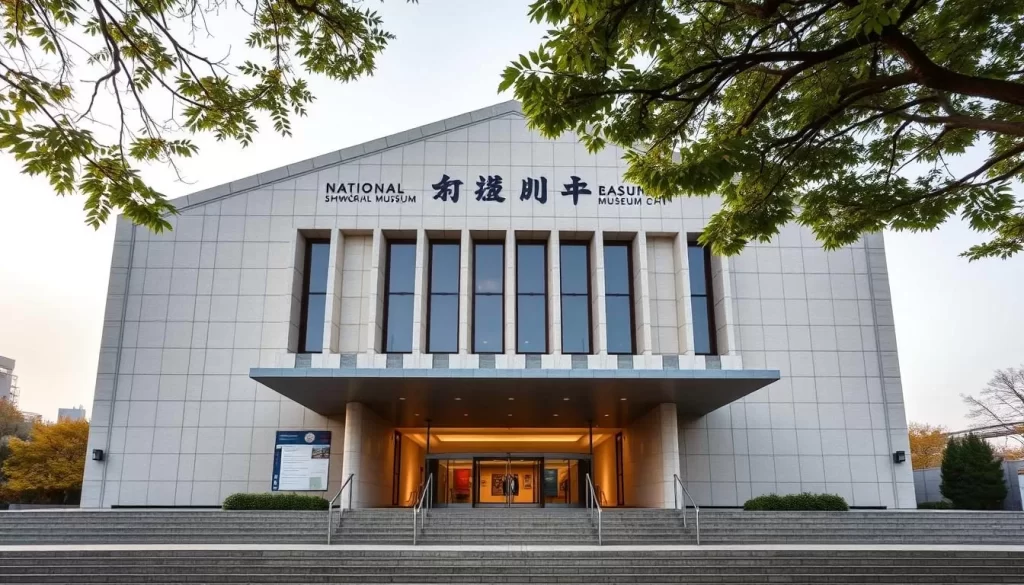
By visiting these cultural landmarks and museums, you’ll gain a deeper understanding of Tokyo’s rich cultural heritage and its contemporary significance. Whether your interests lie in art, science, or history, Chiyoda-ku has something to offer.
Historic Shrines and Temples
Chiyoda-ku is a treasure trove of historic shrines and temples, each with its own unique story to tell. As you explore this district, you’ll have the opportunity to visit some of Tokyo’s most revered sites.
Yasukuni Shrine
Yasukuni Shrine, located in Kudan-kita, Chiyoda-ku, is a historically significant site that commemorates over 2.46 million Japanese military personnel who died in service to their country. The shrine is famous for its 25-meter-high Torii Gate and the Yashukan Museum on its grounds, which documents Japan’s military history and conflicts.
During spring, Yasukuni Shrine becomes a popular spot for cherry blossom viewing, with around 400 cherry trees that are used by the meteorological agency to officially declare the beginning of spring in Tokyo. The shrine’s cherry blossom season is a beautiful time to visit, with the blossoms adding a touch of elegance to the shrine’s historic grounds.
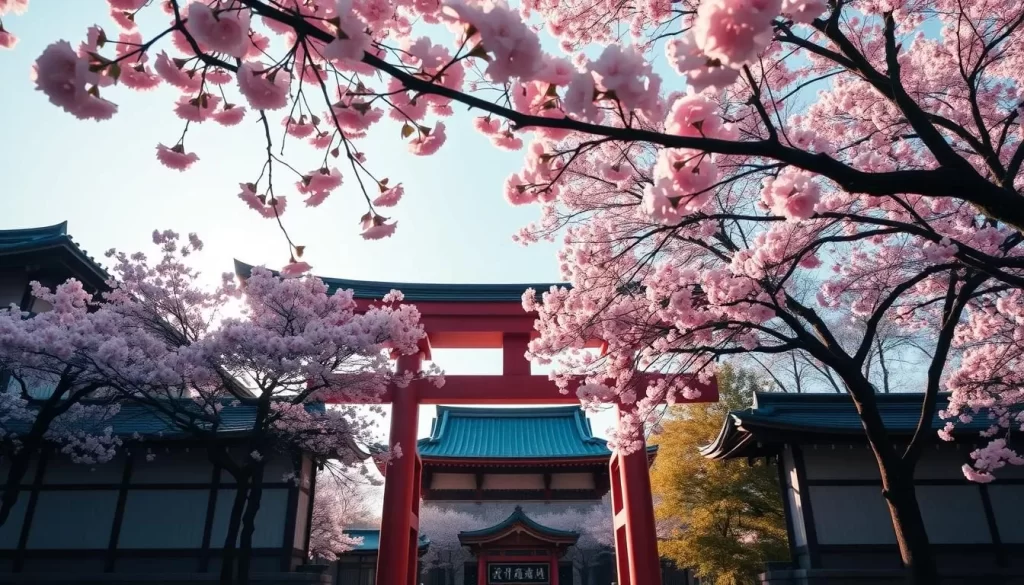
Tokyo Daijingu Shrine
Tokyo Daijingu Shrine, also known as “Tokyo’s Ise-sama,” was built in 1880 as a distant shrine of the famous Ise Jingu Shrine. Originally located in Hibiya, it was relocated to Chiyoda-ku after the Great Kanto Earthquake. The shrine is dedicated to the deities Amaterasu and Toyoke, and is a popular wedding venue, being the originator of Shinto wedding ceremonies in Japan.
Visitors to Tokyo Daijingu Shrine can experience the tranquility of a traditional Shinto shrine, surrounded by the bustling city of Tokyo. The shrine is a significant cultural place in Chiyoda-ku, offering a glimpse into Japan’s rich spiritual heritage.
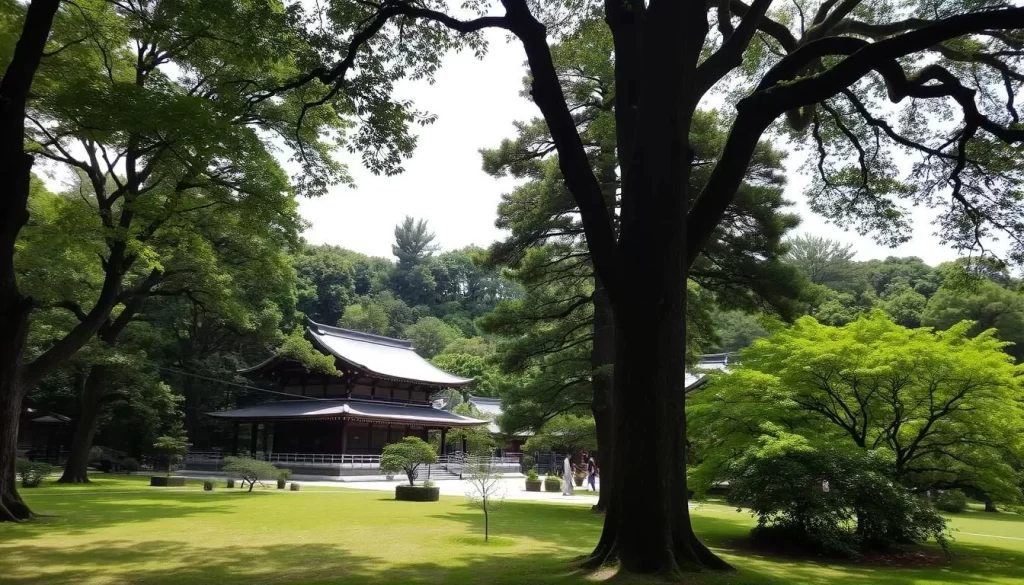
Hie Shrine
Hie Shrine, located in Nagata-cho, Chiyoda-ku, dates back to 1478 and has long been considered the guardian shrine of both Edo Castle and the Imperial Palace. The current shrine pavilion features 123 board paintings commemorating its reconstruction, and the uniquely shaped Sanno torii gate is a notable landmark.
The annual Sanno Festival associated with Hie Shrine is one of the three major festivals of the Edo period, and continues to be celebrated today. Visitors can experience the vibrant atmosphere of the shrine during the festival, which takes place in June every year.
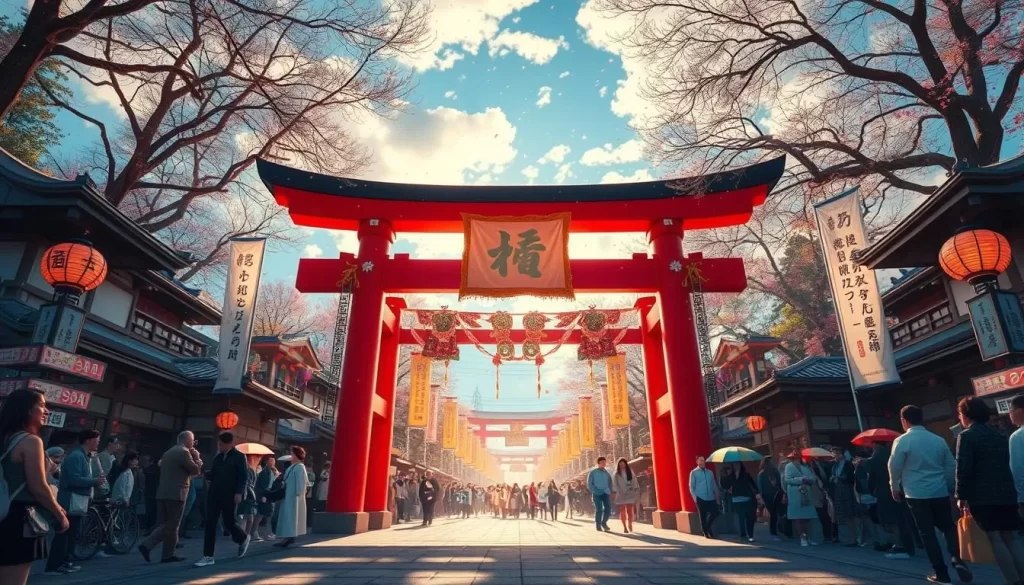
Tokyo Station and Surrounding Area
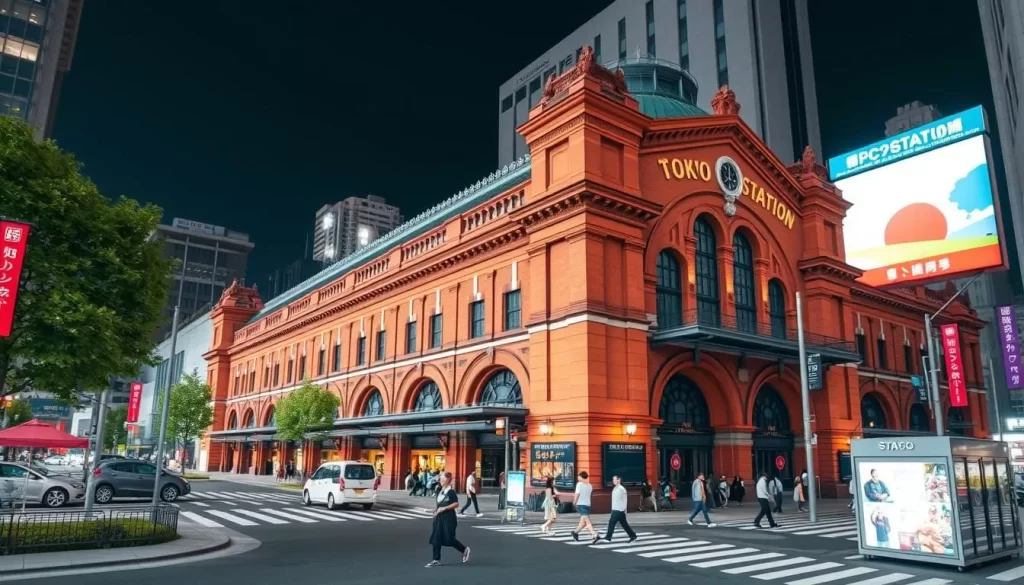
Learn More
With its rich history and stunning architecture, Tokyo Station is an iconic landmark that embodies the spirit of Tokyo. As one of Japan’s busiest train stations, it serves as a major transportation hub, connecting you to various parts of the city and beyond.
Tokyo Station Architecture and History
Tokyo Station’s architecture is a blend of traditional and modern styles. The Marunouchi side, with its red brick building dating back to 1914, is a beautifully preserved example of historical architecture. In contrast, the Yaesu side features a more modern design, showcasing the evolution of architectural styles over time.
The station’s history is equally fascinating, having been restored after damage during World War II and comprehensively renovated in 2012 to return it to its original glory. This blend of old and new makes Tokyo Station a unique cultural landmark.
Marunouchi Business District
The Marunouchi Business District surrounding Tokyo Station has been Tokyo’s financial center since the Edo period. It houses the headquarters of major corporations and megabanks, symbolizing Japan’s financial hub. In recent years, the area has transformed with the addition of numerous commercial facilities, creating a vibrant mix of office spaces, luxury shopping, and dining options.
This district is not just about business; it’s also a place where you can experience the city’s dynamic energy and explore the latest trends in shopping and dining.
Tokyo Station Gallery
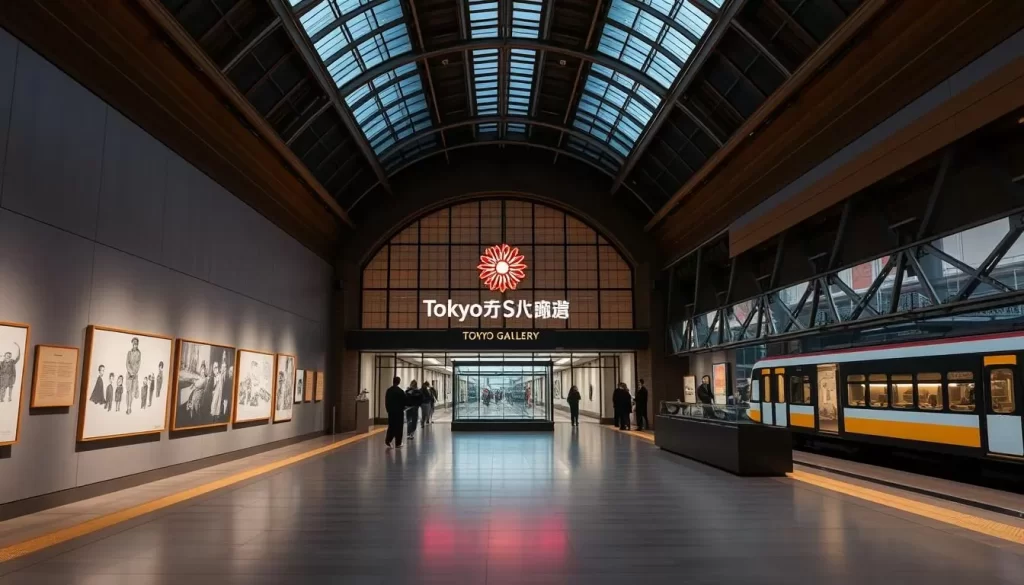
Located within the Marunouchi Station Building, the Tokyo Station Gallery hosts rotating exhibitions on various genres, including modern and contemporary art, railroads, architecture, and design. The gallery’s charm lies in its historic red brick walls, which add a unique touch to the exhibitions.
Visitors can explore a range of exhibitions, from art to history, and appreciate the gallery’s role in preserving and showcasing Japan’s cultural heritage.
Chiyoda-ku, Tōkyō, Japan: Best Things to Do – Top Picks
Discover the best of Tokyo in Chiyoda-ku, a ward that seamlessly blends tradition and modernity. This district is home to a wide range of attractions and activities that cater to different interests and preferences.
Imperial Palace Cycling Tour
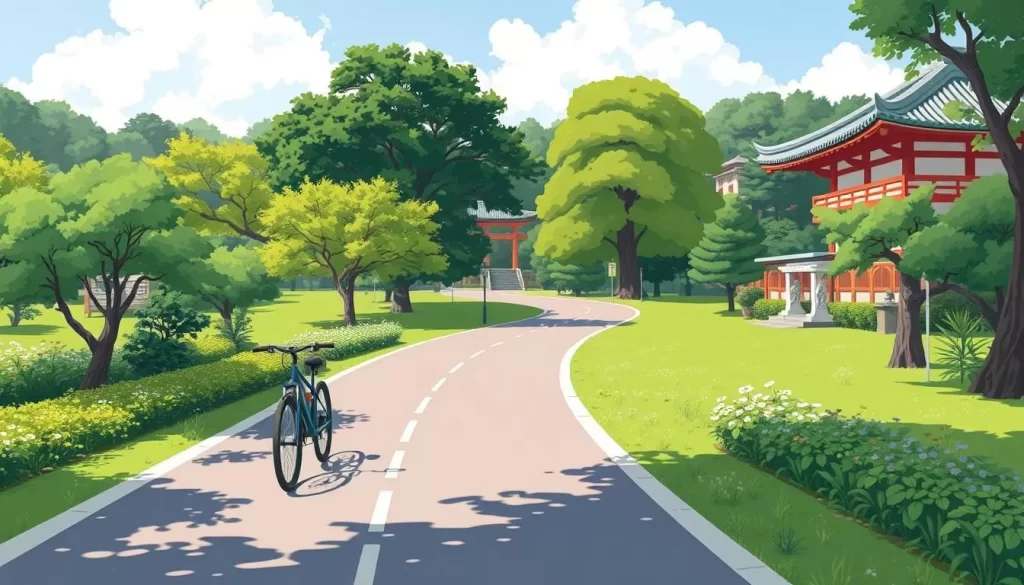
Experience the Imperial Palace Cycling Tour, one of the most enjoyable ways to explore the palace grounds and surrounding area. With rental bicycles available nearby, you can take a leisurely ride around the 5km palace moat, enjoying the scenic views of the palace walls, moats, and gardens. This unique perspective allows you to cover more ground than walking while still experiencing the open air and beauty of the palace surroundings.
The Imperial Palace, the main residence of the Emperor of Japan, is a must-visit attraction in Chiyoda-ku. The cycling tour provides a unique and relaxing way to appreciate the palace’s grandeur and historical significance.
Experiencing a Traditional Tea Ceremony

Immerse yourself in Japanese culture by participating in a traditional tea ceremony in one of Chiyoda’s authentic tea houses. You’ll learn about the centuries-old ritual of preparing and serving matcha, a powdered green tea that is an integral part of Japanese heritage. This experience allows you to appreciate the tranquility and mindfulness that are central to the traditional Japanese tea ceremony.
By experiencing a traditional tea ceremony, you can gain a deeper understanding of Japanese culture and its values. The serene atmosphere and precise movements involved in the ceremony create a unique and memorable experience.
Exploring Jimbocho Book Town
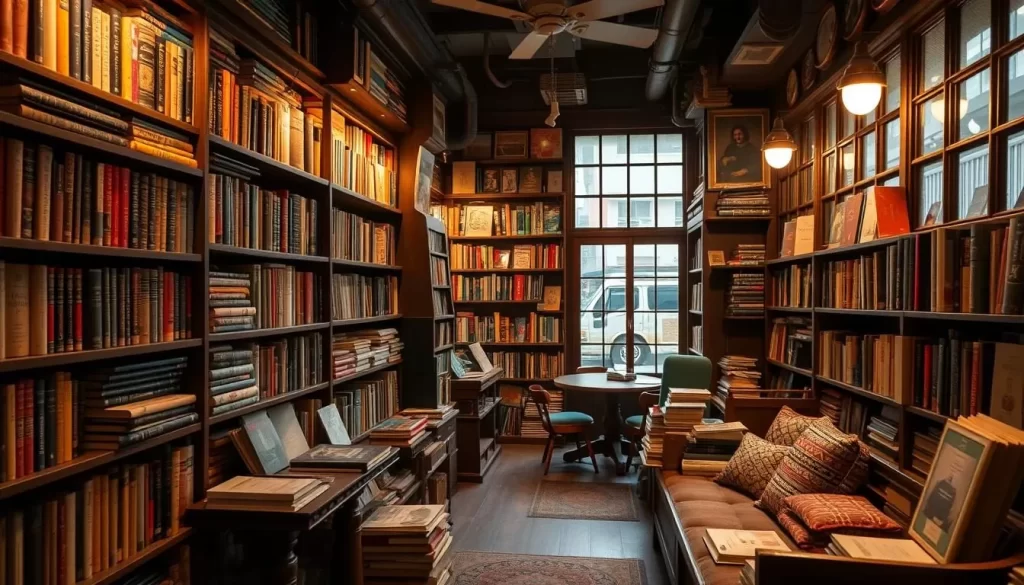
Explore Jimbocho Book Town, home to one of the largest collections of antiquarian bookstores in East Asia. Bibliophiles can spend hours browsing through rare books, vintage magazines, and academic texts, discovering unique and often hard-to-find publications. The area is also known for its curry restaurants, making it a “fierce battleground for curry enthusiasts” with various unique takes on this popular dish.
Jimbocho Book Town offers a fascinating experience for book lovers and those interested in culinary adventures. The combination of old and new, with historic bookstores alongside modern eateries, creates a captivating atmosphere that reflects the diverse character of Chiyoda-ku.
Visiting the Tokyo International Forum is another highlight of your trip to Chiyoda-ku. This impressive convention and arts center features a stunning glass atrium that can be visited for free, representing one of Tokyo’s most distinctive architectural achievements. Additionally, the Oedo Antique Market held here on the first and third Sunday of every month offers a chance to find authentic Japanese pottery, kimonos, and Western tableware.
By exploring these top picks, you can experience the perfect balance of cultural immersion, physical activity, and intellectual stimulation that showcases the diverse attractions of Chiyoda-ku. Whether you’re interested in history, culture, or simply enjoying the city’s atmosphere, Chiyoda-ku has something to offer.
Parks and Green Spaces
Parks and green spaces in Chiyoda-ku provide a tranquil oasis amidst the urban landscape of Tokyo. These areas are not only perfect for relaxation and recreation but also host various events throughout the year, making them vibrant destinations for both locals and tourists.
Hibiya Park
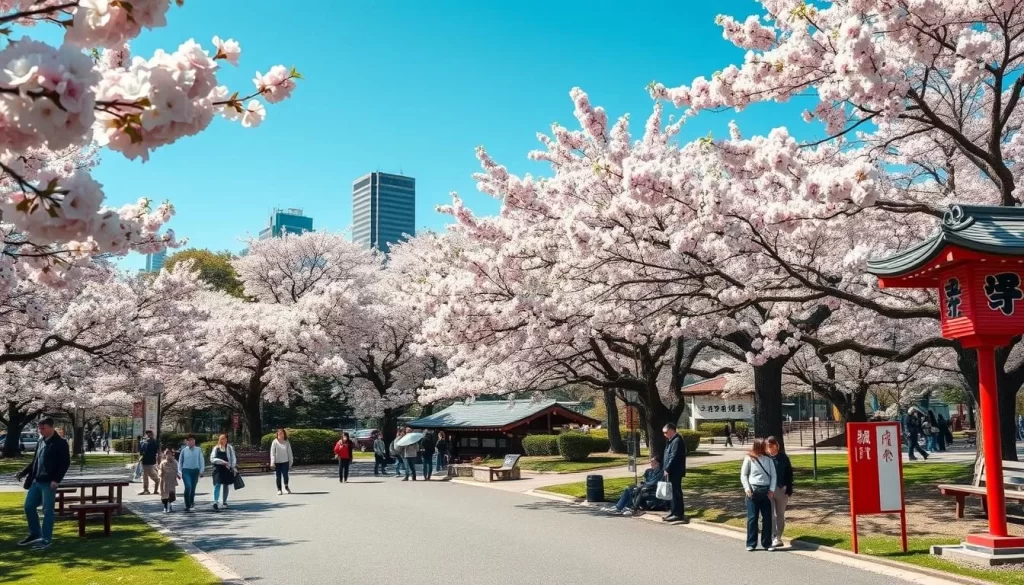
Hibiya Park, established in 1903 as Japan’s first modern Western-style park, is an urban oasis in the heart of Tokyo’s bustling Chiyoda district. The park is known for its beautiful flowers and trees, hosting various events throughout the year, including gardening shows and a Christmas market. During cherry blossom season, Hibiya Park becomes one of Japan’s most popular cherry blossom spots, offering vibrant views that attract visitors from all over.
The park’s design reflects Western influences, making it a unique cultural landmark in Tokyo. Visitors can enjoy leisurely strolls, attend outdoor concerts, or simply relax in the serene environment. Hibiya Park is a great place to experience the changing seasons, with cherry trees blooming in spring and colorful foliage in autumn.
Kitanomaru Park
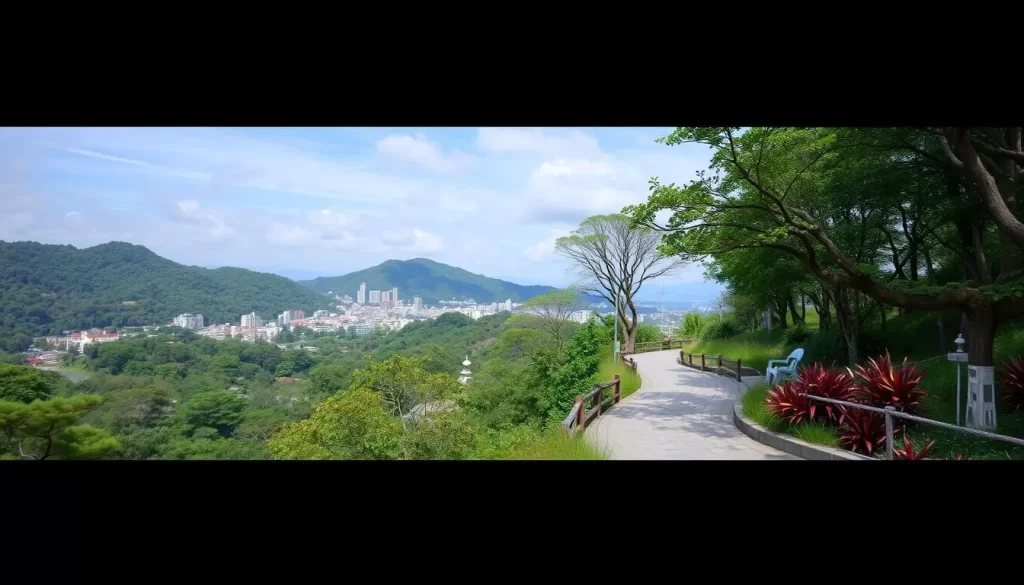
Located on the former site of Edo Castle’s inner moat area, Kitanomaru Park now offers spacious grounds with lush greenery and walking paths. The park is also home to the Nippon Budokan martial arts arena, making it a significant cultural and historical area. Visitors can enjoy a peaceful time in the park, exploring its gardens and monuments.
Kitanomaru Park is particularly famous for its cherry blossom views, attracting many visitors during the spring season. The park’s tranquil atmosphere provides a welcome escape from the hustle and bustle of city life, making it an ideal place for relaxation and recreation.
Chidorigafuchi Moat
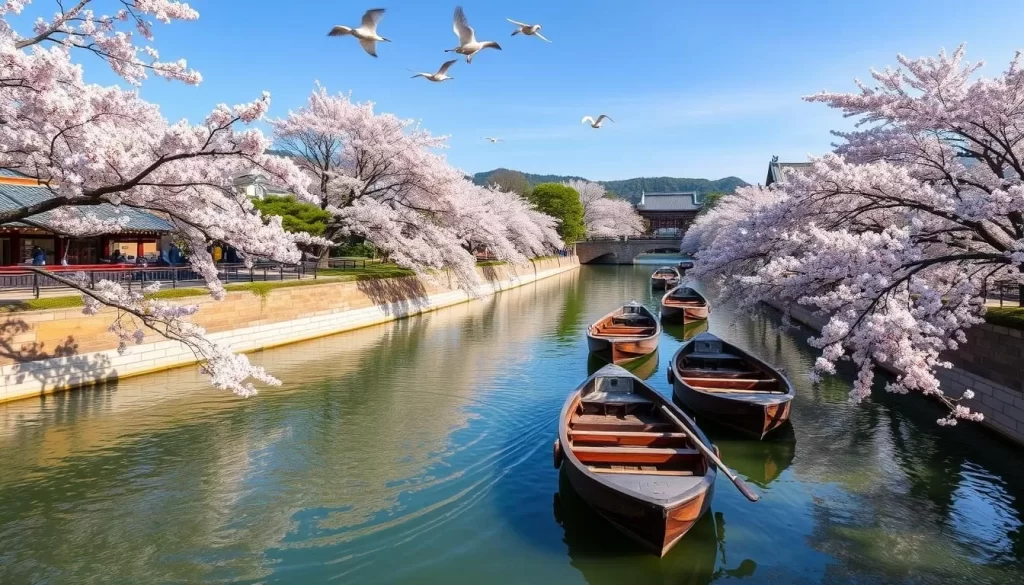
Chidorigafuchi Moat is another popular destination in Chiyoda-ku, especially during cherry blossom season. The moat becomes a picturesque spot with the blooming cherry trees, creating a beautiful landscape. Visitors can enjoy a leisurely boat ride along the moat, taking in the stunning views of the blossoms.
During the peak season, Chidorigafuchi Moat can become quite crowded, with many students and locals gathering to admire the blossoms. Some universities even implement “hanami bans” to prevent rowdy gatherings. Nonetheless, the moat remains a magical place to experience the beauty of nature in the heart of Tokyo.
The special illumination events held at Chidorigafuchi from 4:30 pm to 8:00 pm during cherry blossom season add to its allure, creating enchanting nighttime views of the blossoms reflected in the water. It’s a unique experience that showcases the beauty of Tokyo’s gardens and green spaces.
Shopping Districts in Chiyoda
As you explore Chiyoda, you’ll discover a range of shopping districts that showcase the best of Tokyo. From luxury brands to cutting-edge electronics, the area offers a diverse shopping experience that caters to various tastes and preferences.
KITTE Marunouchi Complex
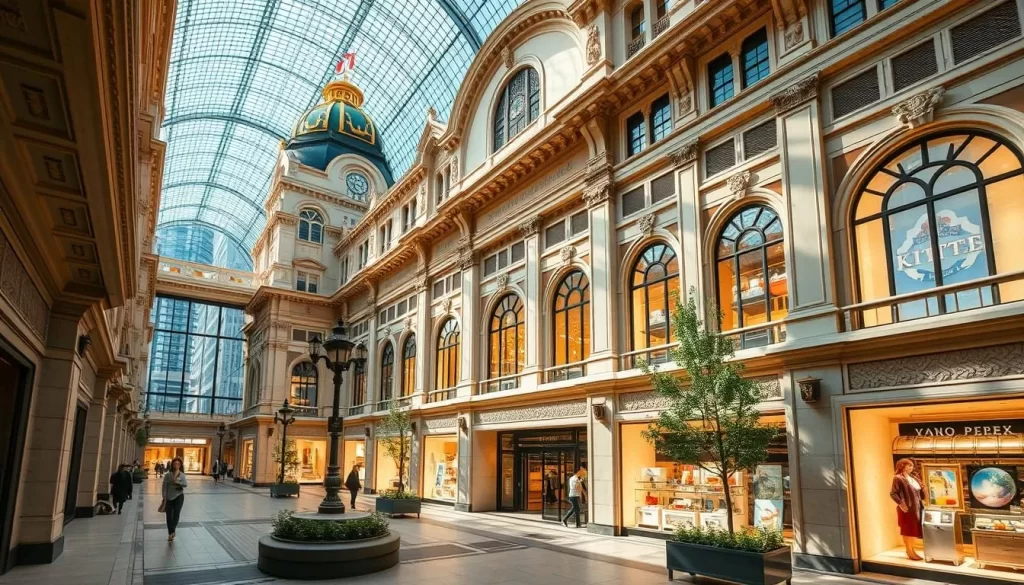
Learn More
KITTE Marunouchi Complex is a must-visit destination for anyone looking for a sophisticated shopping experience. Opened in 2013, this complex is located in the former Tokyo Central Post Office building near the Marunouchi South Exit of JR Tokyo Station. The seven floors of KITTE house gourmet restaurants, specialty stores, and sophisticated shops themed around the “Japanese sense of beauty” and contemporary fashion, all arranged around a stunning atrium.
The artistic atrium interior and the rooftop garden are must-sees, offering excellent views of Tokyo Station and the surrounding area. The rooftop garden is particularly noteworthy, providing a perfect spot for photos and relaxation after shopping.
Marunouchi Nakadori Street
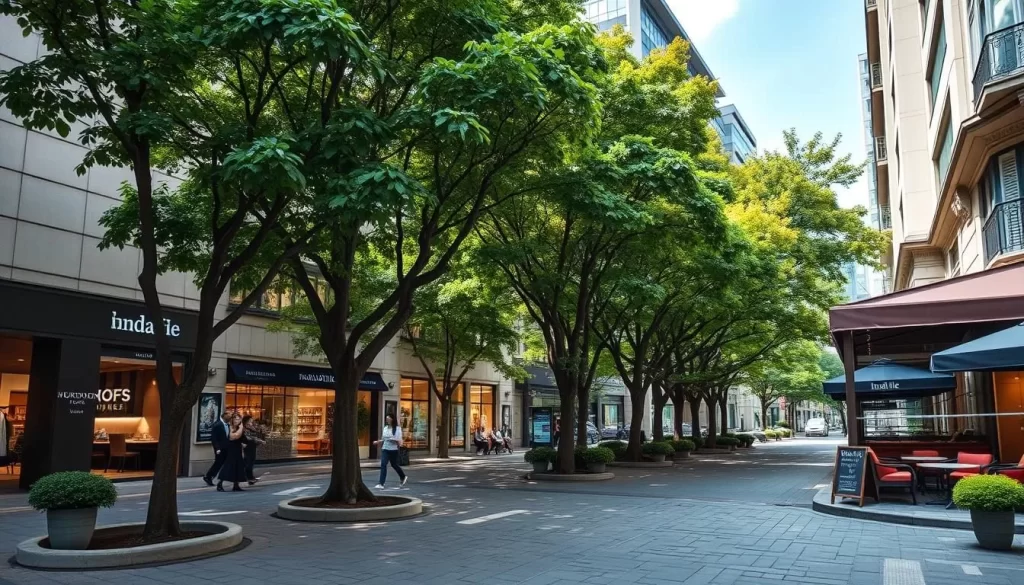
Marunouchi Nakadori Street is an elegant shopping avenue that offers a luxurious shopping experience. This stone-paved street, lined with trees on both sides, is home to numerous luxury brand boutiques, upscale restaurants, and stylish cafés. As you stroll down this street, you’ll be surrounded by the epitome of elegance and sophistication, making it a perfect place to indulge in some retail therapy or simply enjoy the ambiance.
Akihabara Electric Town
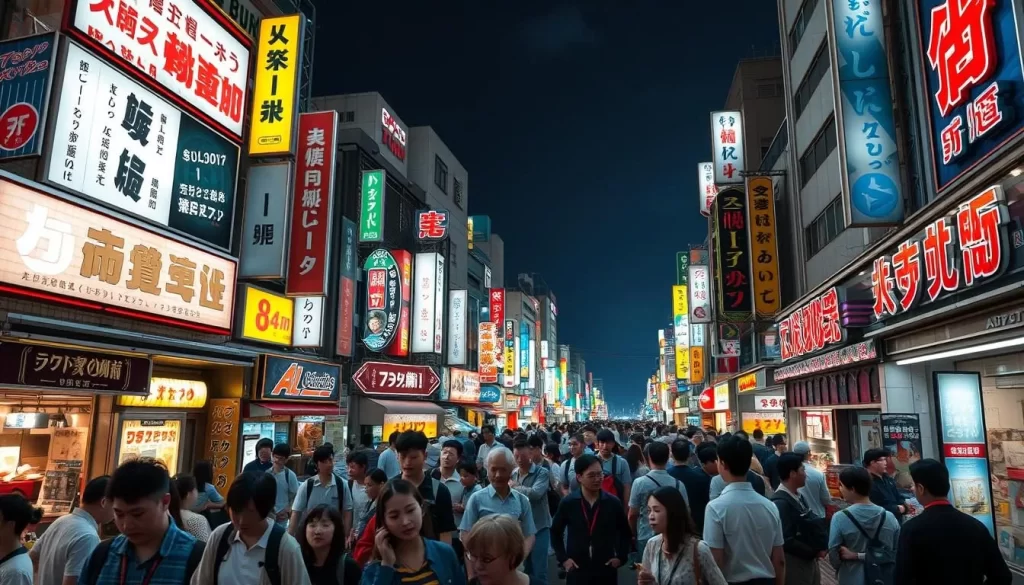
Akihabara Electric Town, also known as Tokyo’s “otaku hub,” is a fascinating district that has evolved significantly over the years. Once a gathering place for professionals centered around the Kanda fruit and vegetable market, it now hosts numerous foreign cell phone shops and has become the epicenter of anime, manga, and gaming culture. Despite these changes, Akihabara retains its core identity as an electronics marketplace while embracing its newer role as a cultural center for Japanese pop culture enthusiasts.
The area is characterized by high-rise office buildings and complexes that continue to evolve, offering a unique blend of technology, culture, and entertainment. As you explore Akihabara, you’ll experience the vibrant energy of this iconic district, making it a must-visit destination for anyone interested in Tokyo’s pop culture scene.
Dining Experiences in Chiyoda
Dining in Chiyoda is an adventure, with Tokyo Ramen Street, traditional eateries, and unique dining spots waiting to be explored. As you navigate through this vibrant district, you’ll discover a wide array of culinary delights that showcase the best of Japanese cuisine and beyond.
Tokyo Ramen Street
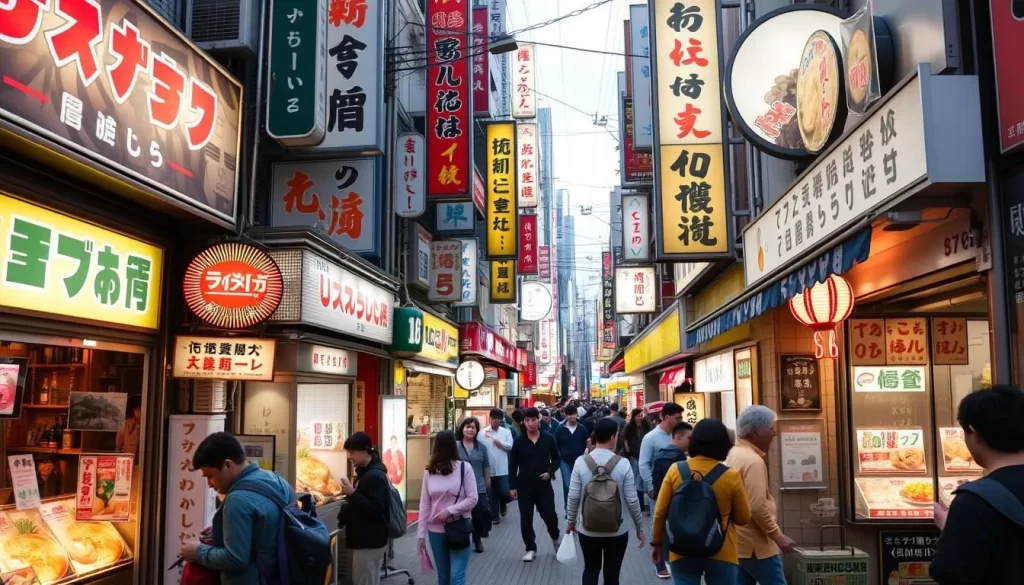
Located underneath Tokyo Station, Tokyo Ramen Street is a culinary destination that attracts both locals and tourists alike. This famous alleyway is home to a collection of small, specialized ramen restaurants, each offering a unique take on this beloved Japanese dish. From traditional tonkotsu (pork bone) and shoyu (soy sauce) broths to innovative fusion creations, Tokyo Ramen Street is the perfect place to grab a delicious meal, especially during lunch or dinner time when the restaurants are bustling with activity.
Whether you’re arriving at or departing from Tokyo Station, Tokyo Ramen Street is a must-visit for any food enthusiast. The variety of ramen styles available ensures that there’s something for everyone, making it an ideal spot to experience the rich flavors of Japanese cuisine.
Traditional Japanese Cuisine
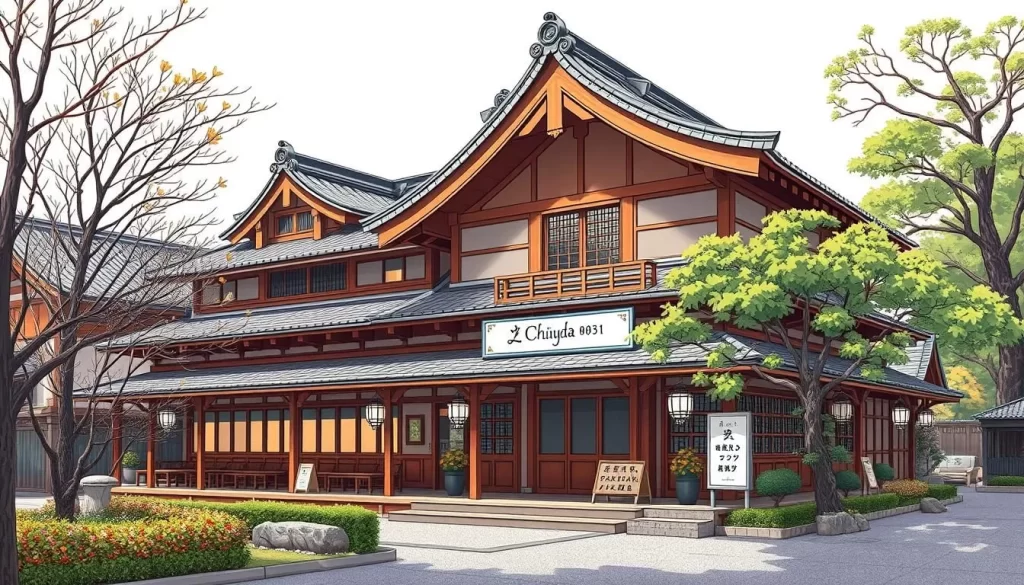
Chiyoda is also home to a wide range of traditional Japanese cuisine options, from high-end kaiseki (multi-course) restaurants to more accessible teishoku (set meal) establishments. These eateries showcase authentic Japanese flavors and offer a culinary experience that is deeply rooted in the country’s culture and traditions.
Whether you’re in the mood for sushi, tempura, or kaiseki, Chiyoda’s traditional Japanese restaurants are sure to impress. Many of these establishments are located in historic buildings and complexes, adding to the ambiance and charm of the dining experience.
Unique Dining Spots
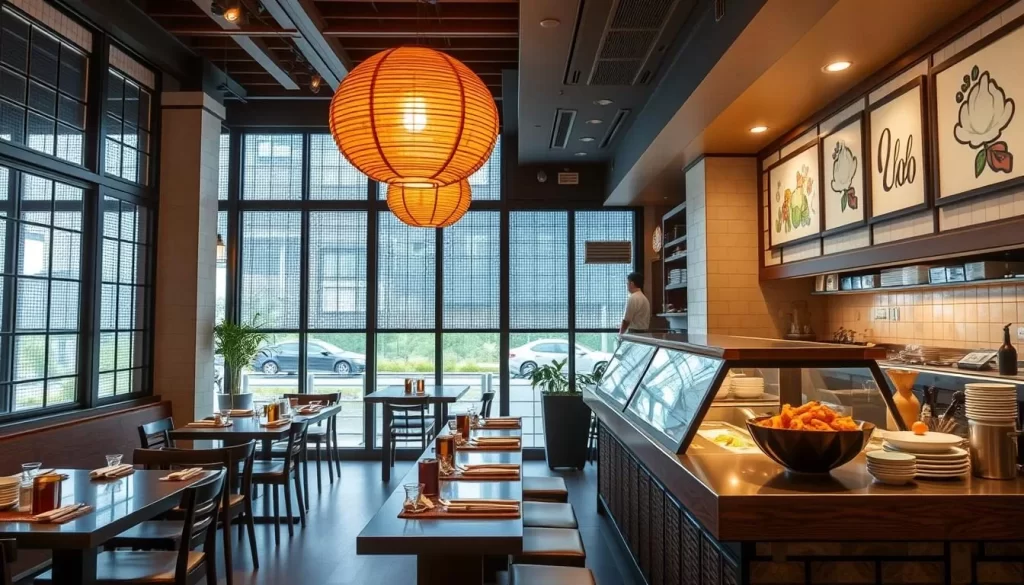
For those looking for something beyond traditional Japanese cuisine, Chiyoda offers a variety of unique dining spots that provide specialized food experiences. From tempura counters where chefs prepare crispy battered seafood and vegetables right before your eyes to modern fusion restaurants that blend international flavors with Japanese ingredients, there’s no shortage of innovative dining options in the area.
These unique dining spots not only offer a delicious meal but also an immersive culinary experience that is sure to leave a lasting impression. Whether you’re a foodie or just looking to try something new, Chiyoda’s unique dining spots are definitely worth exploring.
Seasonal Highlights and Festivals
Experience the best of Tokyo’s culture and nature in Chiyoda-ku, where each season brings its own magic. From the breathtaking beauty of cherry blossoms to the vibrant energy of traditional festivals, Chiyoda-ku is a district that seamlessly blends tradition with modernity.
Cherry Blossom Season at Chiyoda
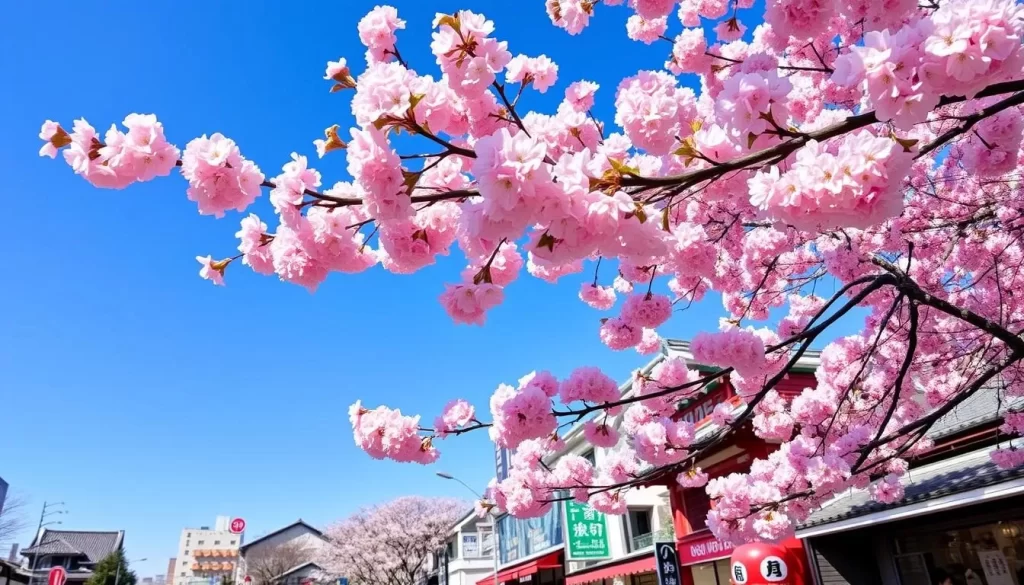
Chiyoda-ku is one of Tokyo’s premier destinations for cherry blossom viewing, or hanami. The district boasts several spectacular viewing spots, including the Chidorigafuchi Moat and Yasukuni Shrine. During the evening hours (4:30 pm – 8:00 pm), special cherry blossom illuminations take place, creating enchanting nighttime views.
The cherry trees at Yasukuni Shrine are particularly significant, as they’re used by Japan’s meteorological agency to officially declare the beginning of Tokyo’s spring blossoming season. With around 400 cherry trees on its grounds, Yasukuni Shrine is a must-visit during cherry blossom season.
Kanda Festival
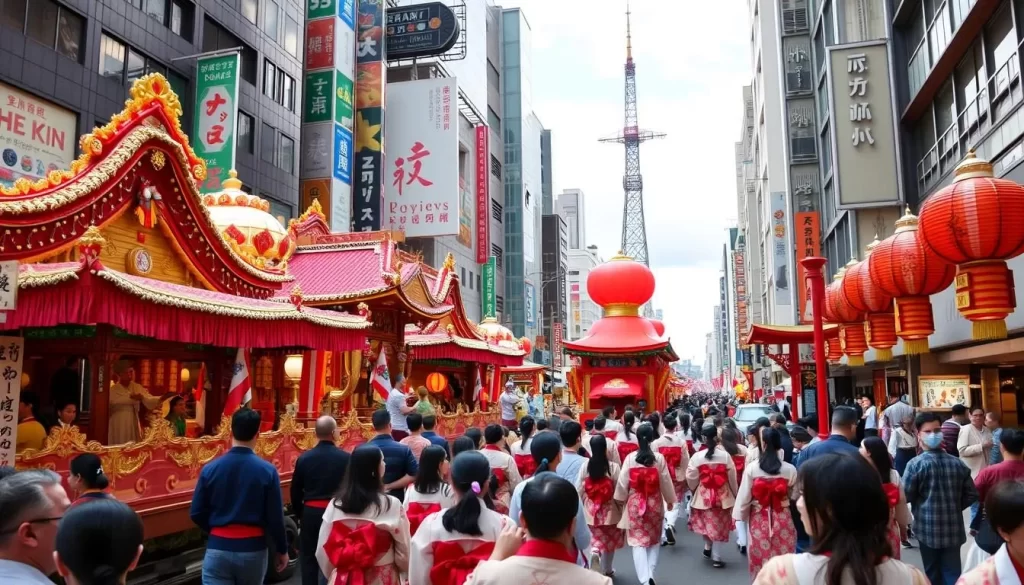
The Kanda Festival, held at the Kanda Myojin shrine, is one of the three major festivals in Edo, along with the Sanno Festival and the Fukagawa Festival. This historic festival features elaborate parades and portable shrines (mikoshi), attracting visitors from across Japan.
The Kanda Festival is a significant cultural event, showcasing the rich heritage of Tokyo. It’s a time when tradition and modernity come together, creating a unique experience for all who attend.
Sanno Festival
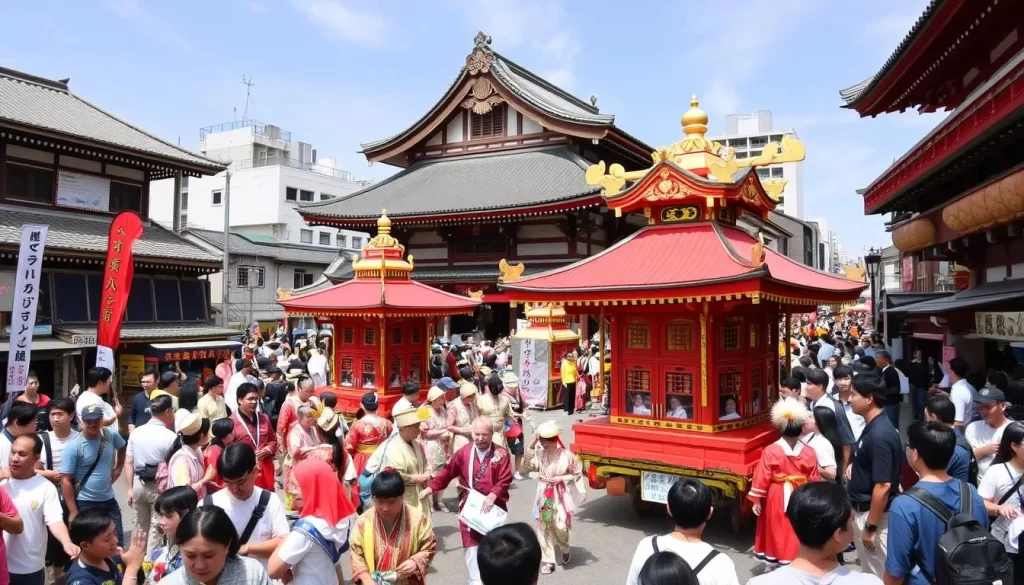
The Sanno Festival, held every June at Hie Shrine, is another of Tokyo’s three great Edo-period festivals. The festival features a spectacular 300-meter-long procession, attracting many visitors. It’s a place where you can witness the grandeur of traditional Japanese culture.
During the Sanno Festival, the atmosphere is electric, with participants dressed in traditional attire. It’s an experience that allows you to step back in time and appreciate the cultural heritage of Japan.
In conclusion, Chiyoda-ku offers a wide range of seasonal highlights and festivals that are worth experiencing. Whether you’re visiting during cherry blossom season or attending one of the district’s major festivals, you’re sure to have a memorable experience in this vibrant part of Tokyo.
Architecture and Modern Landmarks
As you explore Chiyoda-ku, you’ll discover a fascinating mix of architectural achievements that define Tokyo’s landscape. This district is home to some of the city’s most iconic and historically significant buildings, showcasing a blend of traditional and modern architectural styles.
Tokyo International Forum
The Tokyo International Forum is a striking example of modern architecture in Chiyoda-ku. This convention and arts center is renowned for its symbolic glass atrium, which can be visited for free. The atrium is not only a masterpiece of contemporary design but also a vibrant public space that hosts various events and exhibitions throughout the year.
As a significant landmark near Tokyo Station, the Tokyo International Forum represents Japan’s innovative approach to architecture and event hosting. Its design seamlessly integrates functionality with aesthetic appeal, making it a must-visit for architecture enthusiasts and event attendees alike.
Mitsubishi Ichigokan Museum
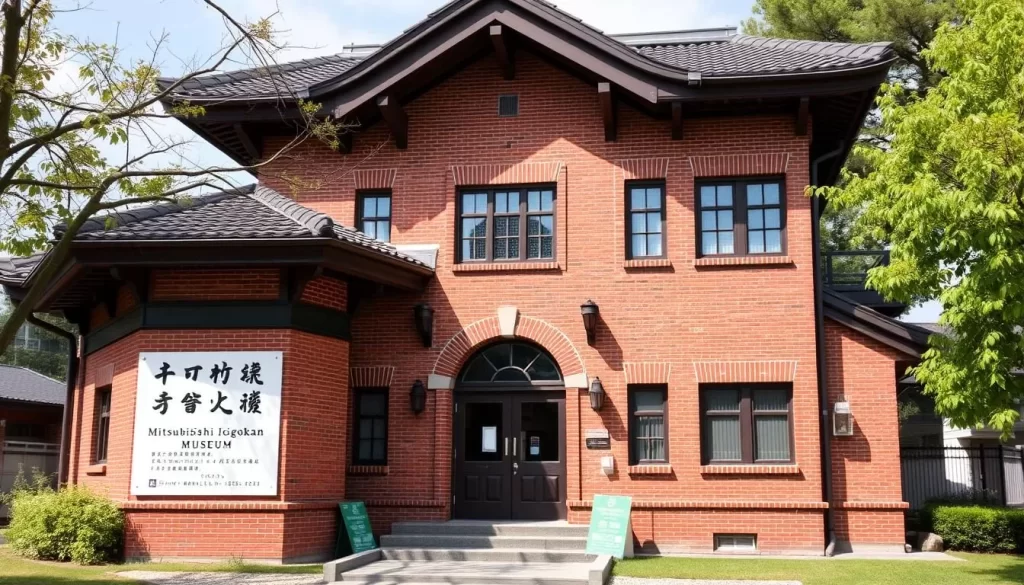
The Mitsubishi Ichigokan Museum is a testament to the rich architectural heritage of Marunouchi. Housed in a meticulously restored red brick building that was originally designed by British architect Josiah Conder in 1894, the museum offers a unique glimpse into Japan’s architectural past.
The museum focuses on modern art from the late 19th and early 20th centuries, with special exhibitions held three times a year. Visitors can appreciate the blend of historical architecture and contemporary art, making for a rich cultural experience.
National Diet Building
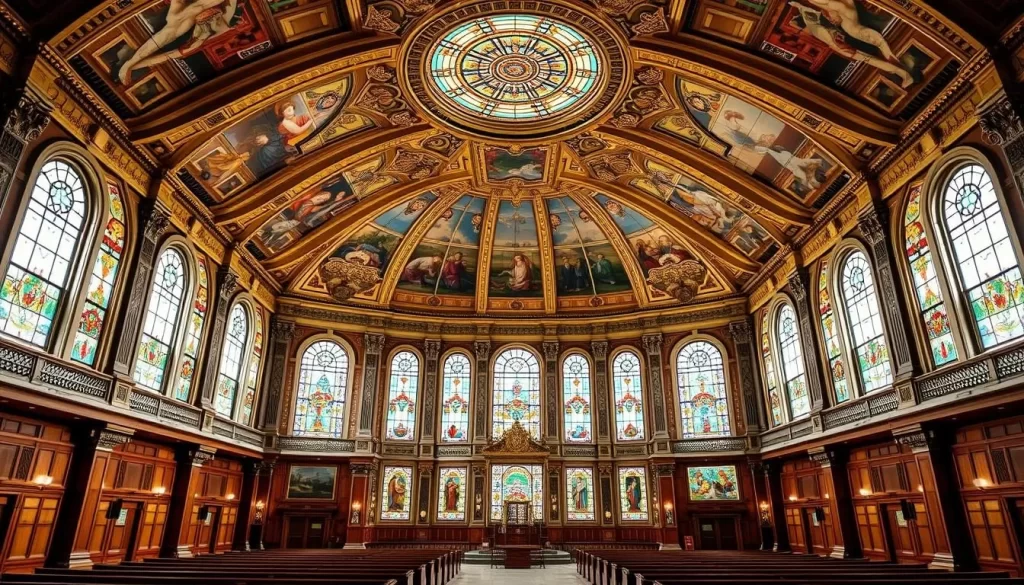
The National Diet Building is the center of Japan’s political activity and a notable example of mid-20th-century architecture. The building took 17 years to complete and features an impressive Central Hall with extensive murals depicting the four seasons and beautiful stained-glass windows.
Visitors can explore the House of Representatives and the House of Councillors, both of which offer tours. While the House of Representatives offers daily tours in English, the House of Councillors’ tours are available on weekdays but in Japanese only. This building is not only a significant political hub but also an architectural landmark that reflects Japan’s parliamentary system.
These architectural landmarks in Chiyoda-ku represent different periods in Japan’s modernization, from the Meiji-era influences seen in the Mitsubishi Ichigokan to the mid-20th-century National Diet Building and the contemporary Tokyo International Forum. They demonstrate Japan’s ability to blend traditional elements with modern functionality, creating structures that are both aesthetically impressive and practically purposeful.
Day Trip Itineraries in Chiyoda
With its blend of historical landmarks and contemporary culture, Chiyoda is a versatile destination for travelers. Whether you’re interested in history, modern experiences, or family-friendly activities, Chiyoda has something to offer. Here, we’ll explore three different day trip itineraries to help you make the most of your visit.
Historical Exploration Route
For those fascinated by history, the Historical Exploration Route is a must. Start your journey at the Imperial Palace grounds, where you can learn about the former Edo Castle and the history of Japan’s imperial family. The palace grounds are steeped in history and offer a serene escape from the bustling city.
From there, head to Yasukuni Shrine and the nearby Yushukan Museum. Yasukuni Shrine is a significant historical site, and the Yushukan Museum provides insight into Japan’s military history. Continue your historical journey by exploring the East Gardens of the Imperial Palace, which showcase how the area has evolved over centuries.
| Stop | Location | Time Required |
|---|---|---|
| Imperial Palace Grounds | 1-1 Chiyoda, Chiyoda-ku, Tokyo | 2 hours |
| Yasukuni Shrine & Yushukan Museum | 3-1-1 Kudankita, Chiyoda-ku, Tokyo | 1.5 hours |
| East Gardens of the Imperial Palace | 1-1 Chiyoda, Chiyoda-ku, Tokyo | 1.5 hours |
Modern Tokyo Experience
Experience the modern side of Tokyo with an itinerary that begins at Tokyo Station, where you can admire its impressive architecture. From there, visit contemporary landmarks like the Tokyo International Forum and the skyscrapers of Marunouchi. This area is perfect for those who want to experience the cutting-edge of Tokyo’s urban culture.
Include shopping experiences at KITTE and along Marunouchi Nakadori Street as part of your modern Tokyo exploration. These areas offer a blend of traditional and contemporary shopping experiences. Finish your day with dinner at one of the innovative restaurants in the area, showcasing Tokyo’s culinary creativity.
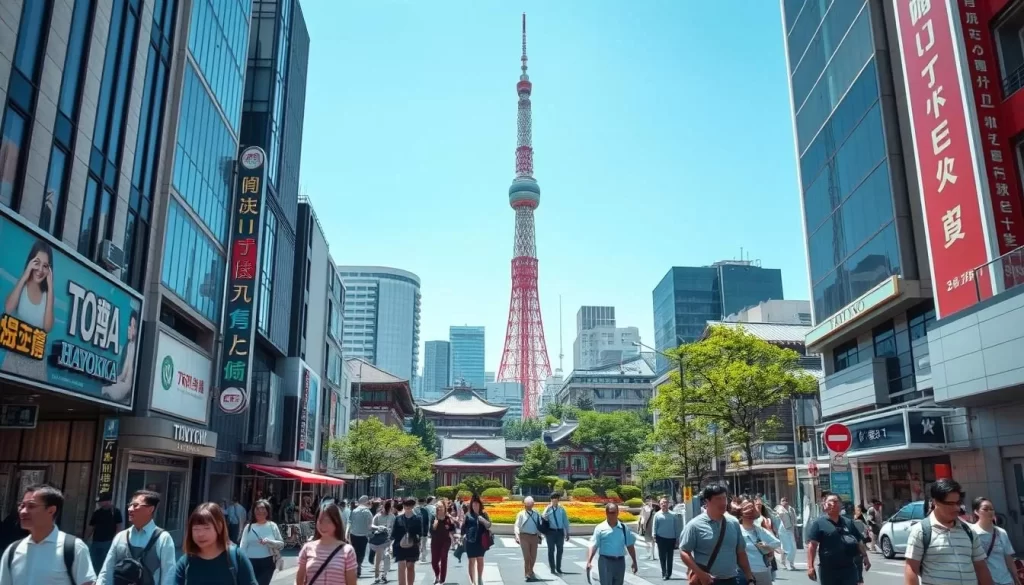
Family-Friendly Itinerary
Chiyoda can be enjoyed by the whole family with a specially designed itinerary. Start with interactive experiences at the Science Museum, which offers engaging exhibits for children. Next, head to Hibiya Park, where kids can run around and enjoy the outdoors. For dining, choose family-friendly options that cater to both children and adults.
When planning your day trips, consider grouping attractions that are within walking distance of each other to maximize your time and see more of what interests you. Allocate approximately a full day if you want to explore Chiyoda thoroughly, or half a day if you’re focusing on selected highlights.
Remember to consider seasonal factors when planning your itinerary, as cherry blossom season or festival times may affect crowd levels and the overall experience at certain attractions.
Where to Stay in Chiyoda
When planning your trip to Tokyo, choosing the right accommodation in Chiyoda-ku can significantly enhance your travel experience. Chiyoda is not just the political heart of Japan, hosting the Imperial Palace and the National Diet Building, but it’s also a district that offers a unique blend of historical significance and modern convenience.
Staying in Chiyoda provides excellent access to major transportation hubs, including Tokyo Station, one of the city’s main railway stations. This makes it an ideal location for travelers planning day trips outside of Tokyo or those who wish to explore the city’s various districts.
Luxury Accommodations
For those seeking a luxurious stay, Chiyoda offers several high-end hotels that combine comfort, elegance, and top-notch service. One such establishment is the Imperial Hotel Tokyo, renowned for its first-class hospitality since 1890.
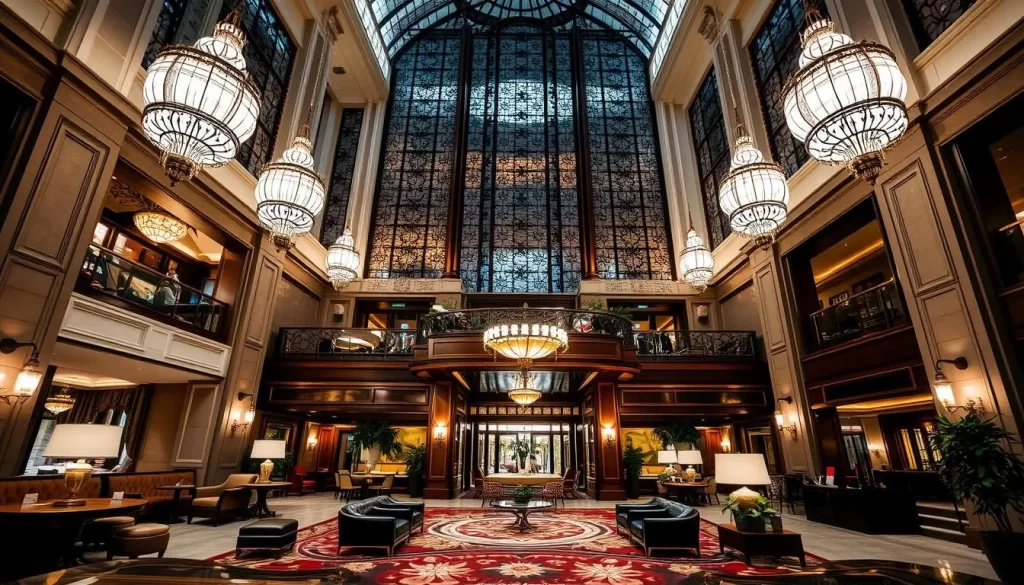
The Imperial Hotel Tokyo features a fitness center, an indoor swimming pool, and a beauty massage salon, ensuring that guests have a comfortable and rejuvenating stay. Its central location provides easy access to Ginza, Hibiya, and Yurakucho stations, making it a convenient choice for exploring Tokyo.
Another luxury option is the Ascott Marunouchi Tokyo, situated just 800 meters from Tokyo Station. This hotel offers elegantly furnished rooms with city views, free WiFi, and an on-site fitness center.
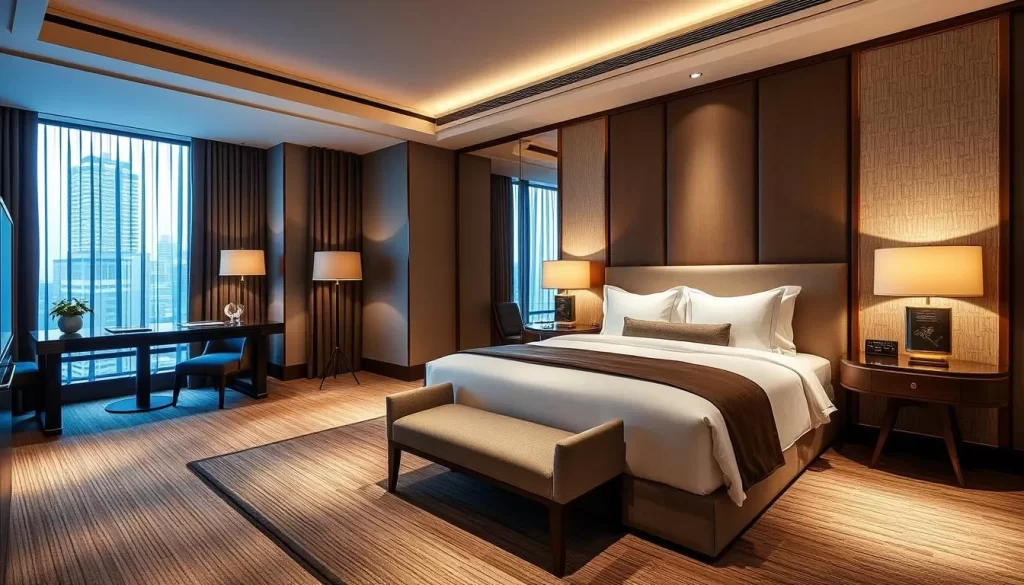
Mid-Range Hotels
Travelers on a moderate budget can find comfortable and conveniently located hotels in Chiyoda. These mid-range hotels offer a balance between affordability and quality, often providing essential amenities and services.
One such option is a hotel near Tokyo Station, which, while not directly in Chiyoda, offers proximity to the area’s attractions. For a more precise location within Chiyoda, hotels like the Daiwa Roynet Hotel series offer comfort and convenience, although specific properties might be located just outside the district.

Budget-Friendly Options
For budget-conscious travelers, Chiyoda and its surrounding areas have several affordable accommodation options. These include budget hotels and guesthouses that offer basic amenities at a lower cost.
While specific budget hotels directly in Chiyoda might be limited, the surrounding districts offer a range of choices. Travelers can consider staying in nearby areas and commuting to Chiyoda, or look for budget-friendly options that are within walking distance to major attractions.
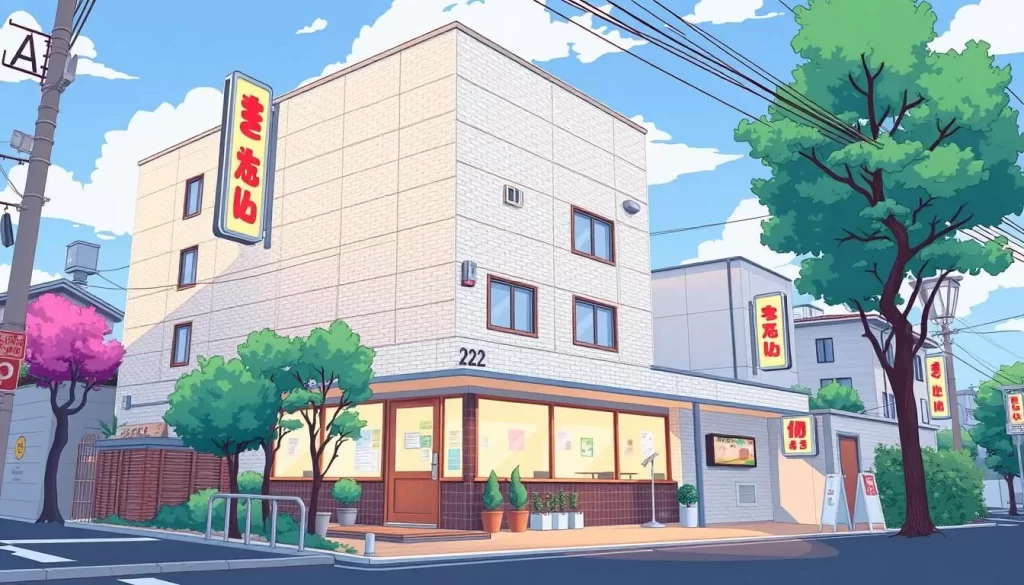
In conclusion, Chiyoda offers a range of accommodations to suit different budgets and preferences. Whether you’re looking for luxury, mid-range, or budget-friendly options, the key is to balance your needs with the convenience of being in a central location.
Getting Around Chiyoda
Getting around Chiyoda is easier than you think, thanks to its excellent public transportation system. Whether you’re looking to explore the city’s historical landmarks, enjoy its green spaces, or experience its vibrant culture, Chiyoda has a transportation option to suit your needs.
Public Transportation Options
Chiyoda is well-connected by multiple subway lines and JR lines that converge at Tokyo Station, making it easy to navigate the area. You can efficiently travel across the district using the subway or JR trains. To make your journey even smoother, consider purchasing a prepaid IC card like Suica or Pasmo. These cards allow seamless travel across different transportation systems, eliminating the need to purchase individual tickets.
With a prepaid IC card, you can easily access key attractions in Chiyoda, such as the Imperial Palace, Tokyo Station, and various cultural landmarks. The public transportation network is extensive, with multiple stations throughout the district, ensuring that you’re never far from your destination.
Walking Routes
Chiyoda is a pedestrian-friendly district, with many of its highlights within walking distance of each other. You can explore the area on foot and discover hidden gems between major sites. One popular walking route is from Tokyo Station to the Imperial Palace, which takes you through the beautiful East Gardens. Another option is to walk from Hibiya Park to the National Diet Building, enjoying the scenic views along the way.
Walking in Chiyoda allows you to experience the area at your own pace, taking in the historical and cultural significance of the landmarks you visit. Be sure to plan your walking route according to the time of day to avoid the crowds and make the most of your visit.
Bicycle Rentals
For a different way to experience Tokyo, consider renting a bicycle. Rental services are available near Tokyo Station and the Imperial Palace, offering a fun and efficient way to cover more ground than walking. You can enjoy the scenic views of Chiyoda while cycling through its streets.
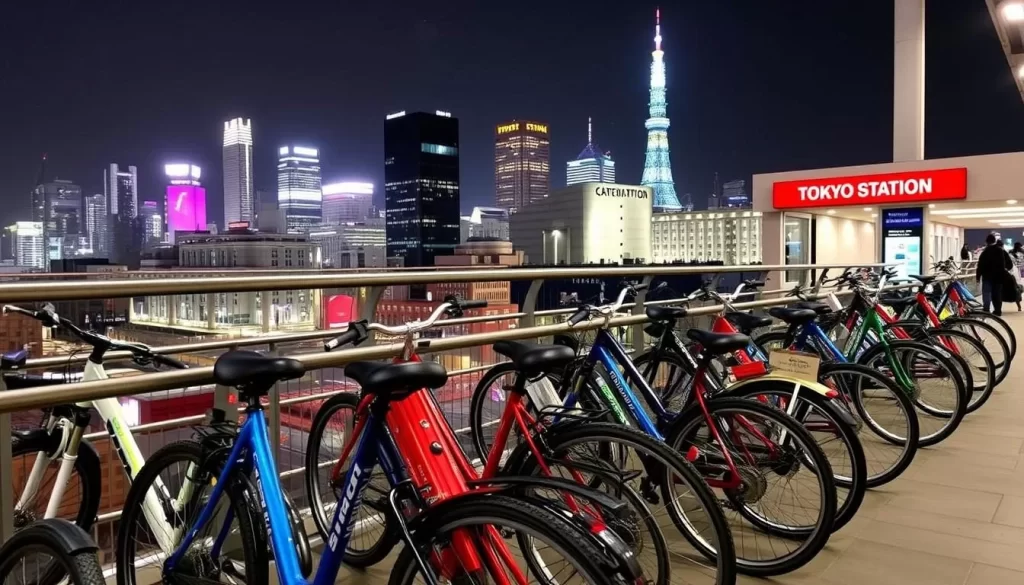
Joining a guided bicycle tour is another great option, providing a unique perspective on the area with knowledgeable guides who can offer historical context and take you to spots you might miss on your own. This is a great way to access hidden gems and enjoy the city from a different perspective.
Practical Tips for Visiting Chiyoda
To make the most of your trip to Chiyoda, understanding the best times to visit and insider tips is crucial. Chiyoda, being the heart of Tokyo, offers a plethora of experiences ranging from historical landmarks like the Imperial Palace to modern attractions such as the museums and shopping districts.
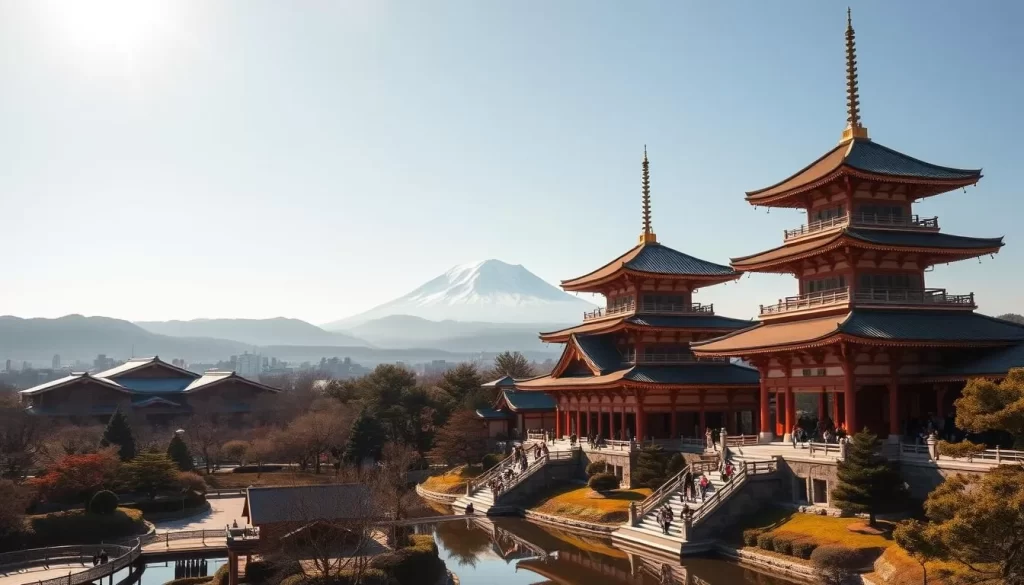
Best Time to Visit
Planning your visit to Chiyoda during the optimal seasons can significantly enhance your experience. The spring season, from late March to early May, is ideal for witnessing the beautiful cherry blossoms. Autumn, spanning from October to November, offers a picturesque landscape with colorful foliage. If you prefer milder weather, consider visiting during the temperate months to avoid extreme weather conditions.
It’s also worth noting that certain attractions have specific visiting times. For instance, the Imperial Palace grounds are not generally open to the public, but you can join guided tours held on Tuesdays through Saturdays at 10:00 and 13:30. These tours last approximately 75 minutes and are available in Japanese and English. To participate, you must apply in advance through the official Imperial Household Agency website.
In contrast, the East Gardens of the Imperial Palace, or Higashi Gyoen, are open to the public and can be visited for free. They are open daily, except for Mondays and Fridays, from 9:00 AM until the closing time, which varies seasonally between 4:00 PM and 6:00 PM.
Money-Saving Tips
Chiyoda offers various ways to save money while still enjoying a rich experience. One effective way is by using prepaid transportation cards, which can simplify your travel across the district. Visiting museums on their free or discounted days is another strategy. Many museums offer combination tickets that can provide significant savings.
Additionally, taking advantage of the free attractions such as the East Gardens of the Imperial Palace can be a great way to experience the beauty of Chiyoda without incurring extra costs. Being mindful of these opportunities can help you plan a budget-friendly trip.
Etiquette and Cultural Considerations
When visiting Chiyoda, respecting Japanese etiquette, especially at shrines and temples, is crucial. This includes proper behavior at purification fountains, appropriate photography practices, and maintaining quiet contemplation in sacred spaces. Learning basic Japanese phrases and customs before your visit can also enhance your experience.
Understanding the importance of cultural considerations such as avoiding eating while walking, speaking quietly on public transportation, and properly disposing of trash can make your visit more enjoyable and respectful. These practices not only reflect positively on you as a visitor but also contribute to a more harmonious experience for everyone involved.
By being aware of these practical tips, you can have a more fulfilling and respectful visit to Chiyoda, enjoying the rich history, cultural landmarks, and modern attractions that this district has to offer.
Conclusion
As you conclude your journey through Chiyoda-ku, it’s clear that this district is a microcosm of Tokyo’s rich history and vibrant culture. With the Imperial Palace and its grounds as its heart, Chiyoda-ku offers a unique blend of historical significance and modern vitality, making it one of Tokyo’s most fascinating districts to explore.
The Tokyo Imperial Palace, the main residence of the Emperor of Japan, is a must-visit attraction, surrounded by beautiful gardens and the remnants of Edo Castle. The area is also home to numerous museums, such as the National Museum of Modern Art and the Science Museum, providing insights into Japan’s art, science, and history.
Cultural landmarks like the Yasukuni Shrine and the National Diet Building add to the district’s historical and cultural richness. Visitors can experience the best of Tokyo’s food scene at various restaurants, from traditional Japanese cuisine to modern dining experiences like Tokyo Ramen Street.
Chiyoda-ku’s central location and excellent public transportation connections make it an ideal base for exploring Tokyo. Whether you’re interested in historical exploration, architectural appreciation, or family-friendly activities, Chiyoda-ku has something to offer. When planning your visit, consider the best times to visit specific attractions and how to navigate the area efficiently to make the most of your experience.
For accommodations, Chiyoda-ku offers a range of options, from luxury hotels to budget-friendly choices, ensuring that visitors can find a suitable place to stay. As you plan your things to do in Chiyoda-ku, consider exploring the different areas of the district, each with its unique character and attractions.
In conclusion, Chiyoda-ku is an essential part of any Tokyo itinerary, offering a perfect introduction to the fascinating contrasts that define Japan’s capital city. With its rich history, cultural landmarks, and modern attractions, Chiyoda-ku is a district that will leave you with unforgettable experiences and a deeper appreciation for Tokyo’s unique blend of tradition and innovation.
The above is subject to change.
Check back often to TRAVEL.COM for the latest travel tips and deals.
